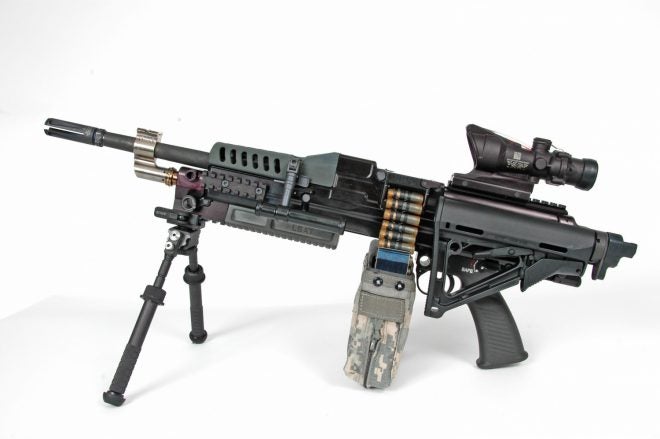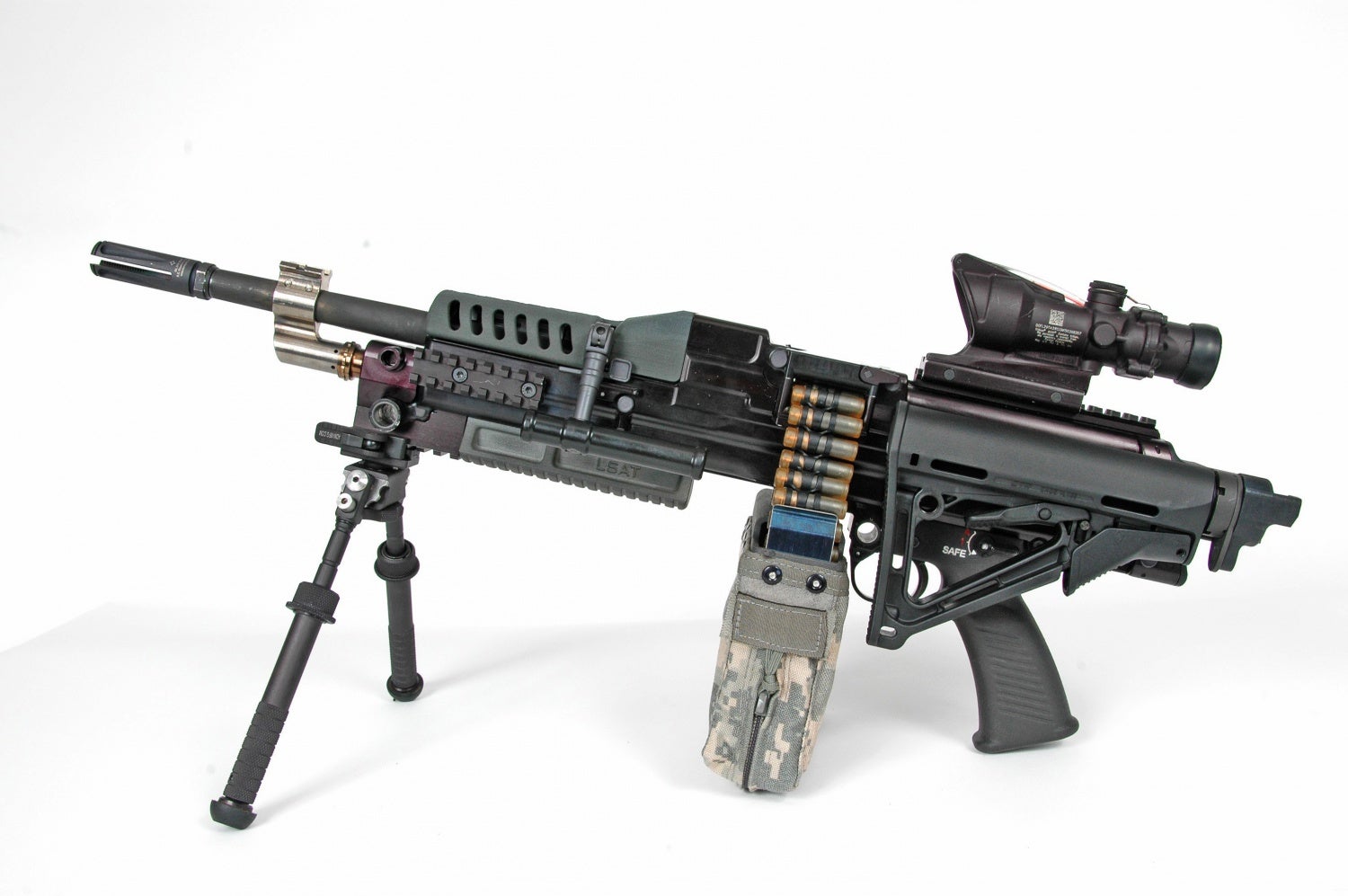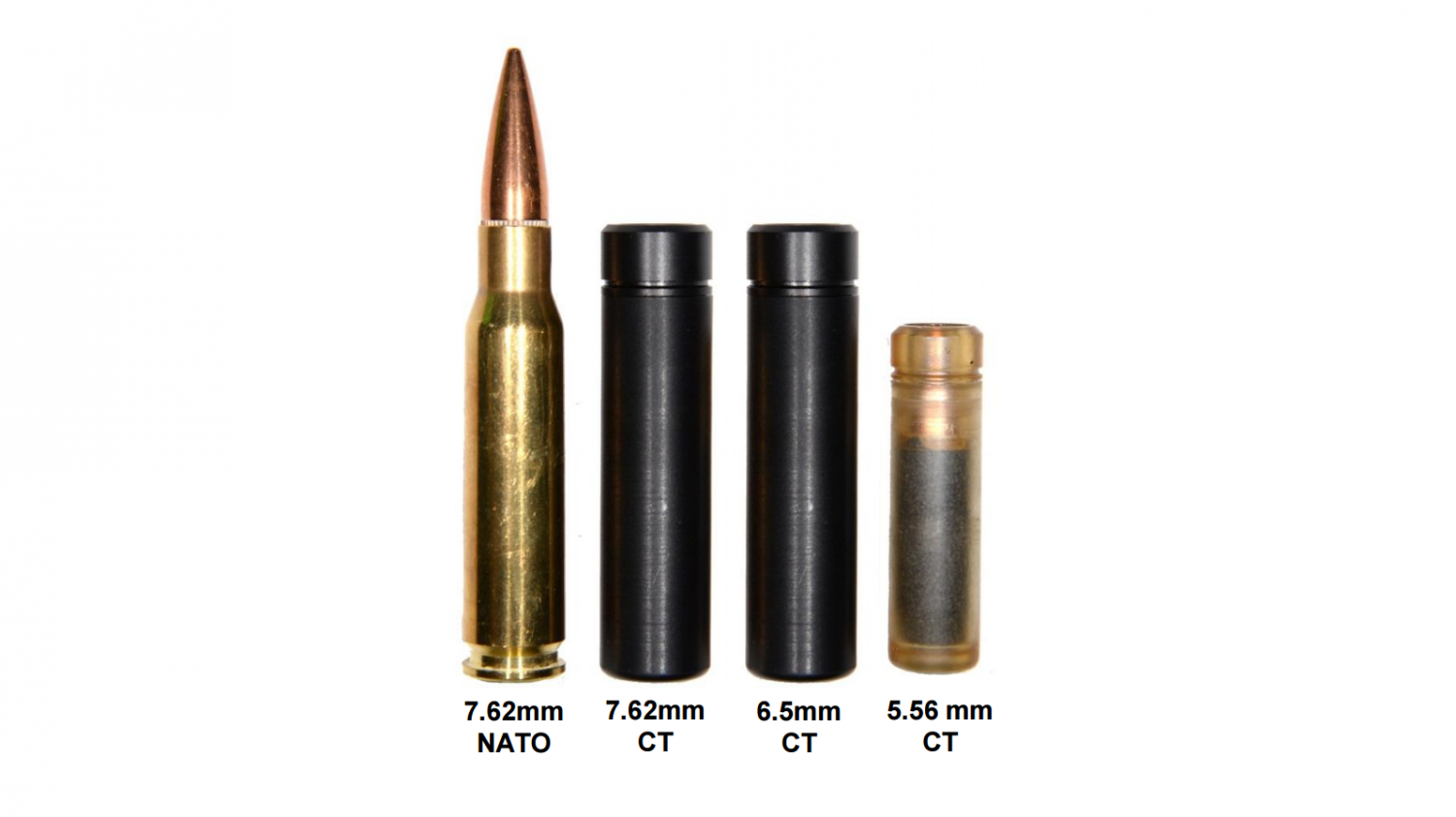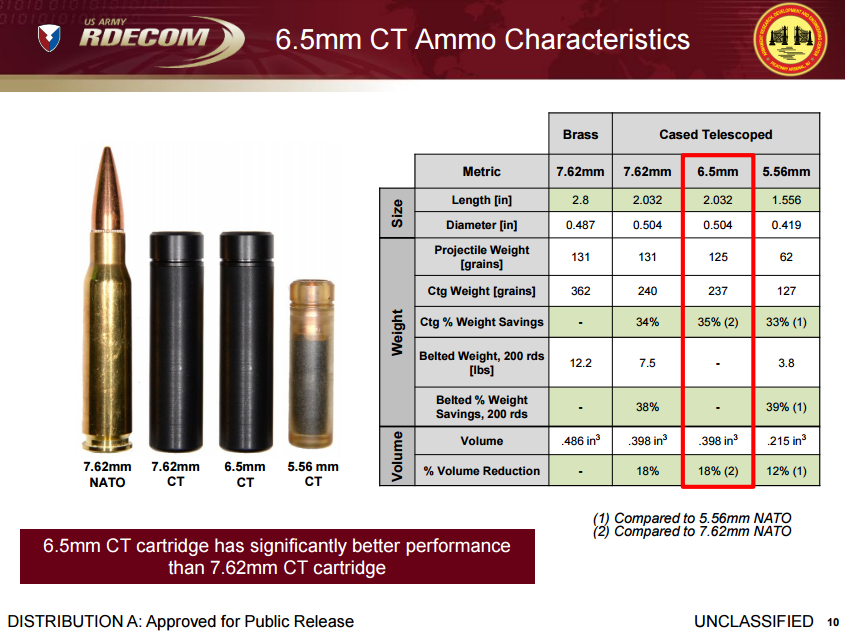Recently, I wrote an editorial regarding the LSAT/CTSAS team’s NDIA presentation on their 6.5mm cased telescoped carbine and machine gun concepts. There was a lot to say about the history of Army programs and the pitfalls facing that team, but today I want to get down to brass tacks and explore the weight savings and/or penalty of issuing to the infantry platoon the 6.5mm CT cartridge Phillips’ team proposed. Like in my November of 2013 article on the general purpose cartridge concept, I will be using the loads reported in the paper The Modern Warrior’s Combat Load, released in 2003. That paper is a little dated, unfortunately, but it’s the most comprehensive survey of the platoon’s loadout of which I am aware.
I am going to approach this from three angles: 1.) What is the weight penalty for replacing 5.56mm and 7.62mm both round-for-round with 6.5mm CT ammunition? 2.) What is the ammunition reduction for replacing 5.56mm and 7.62mm both pound-for-pound with 6.5mm CT ammunition? 3.) What is the weight penalty or reduction for replacing 5.56mm and 7.62mm both round-for-round with a lightened, more optimized 6.5mm CT configuration (which I will call for the purposes of this article “LW 6.5mm CT”)? 4.) What is the weight penalty or reduction for replacing 5.56mm and 7.62mm both round-for-round with 5.56mm CT and 6.5mm CT*? We’ll cover the first two in this post, and the rest in part two.
*Note that 7.62mm CT is almost identical in weight to 6.5mm CT, so this should be illustrative of both.
TFB readers should also know that as I write this, I have not done the calculations yet. So, you will find out as I do what the results are; that’s the best way for me to stay honest. Now, to begin: First, we need to do some preliminary math. Unlike my previous articles using this method, this time I will be accounting for the weight of magazines and belt links (at the time I wrote those articles I could not find or create those figures, so I left them out). So, below I have listed the weights of the different elements in this calculation, with hyperlinks to their sources. In some cases, the weights are calculated from information given in the sources, but for the sake of brevity I will leave out that math. My readers should still be able to check my work, even so. I should finally note that while I have listed weights for all items in grains and grams both, all my math will be done using grams and kilograms only.
Weight of 1 round of 6.5mm CT: 237 grains / 15.4 grams
Weight of 1 belt link for 7.62mm/6.5mm CT: 22.5 grains / 1.46 grams
Weight of 1 round of 5.56mm CT: 127 grains / 8.2 grams
Weight of 1 belt link for 5.56mm CT: 13 grains / 0.84 grams*
*Plastic belt link figures given in various LSAT/CTSAS presentations are all over the place, from 6 grains to 21 grains, so I am using a guesstimated figure of 13 grains for this exercise, which I arrived at simply by scaling down the 22.5 grain figure for the 7.62mm belt link. If there’s an error here, it shouldn’t significantly affect the end result, and using these figures should at least be fair to both calibers.
Weight of 1 round of 5.56mm NATO (M855, M855A1, Mk. 318, or SS109): 185 grains / 12.0 grams
Weight of 1 M27 belt link: 30.9 grains / 2.00 grams
Weight of 1 30-round USGI magazine: 1,750 grains / 113 grams
Weight of 1 round of 7.62mm M80A1 Ball: 356 grains / 23.1 grams
Weight of 1 M13 belt link: 65.1 grains / 4.22 grams
Weight of 1 20-round M14 magazine: 3,580 grains / 232 grams
We are pretty much given the weight figures for everything above, but we don’t know what the weight of the 20-round 6.5mm CT magazine is for the CTSAS 6.5mm carbine. However, this should be fairly easy to estimate. We can start with a known polymer magazine of similar dimensions:
Weight of 1 30-round Gen M3 PMag: 4.9 oz, 2,144 grains, 138.9 grams
And then make some adjustments. First, I want to calculate the volume of each respective cartridge stack, which will inform what the weight adjustment needs to look like. This is easily done, as long as we know the width modifier for double-stacked cartridges. That is:
Width modifier for stacked circles: 1.866
So then we calculate the volume of each respective cartridge stack. Here I have converted all figures into metric using the factor 25.4 mm/in; the raw figures I obtained from the slide from Phillips’ presentation, show below:
So that gives us:
Volume of 30-round column of 5.56mm cartridges: 1.866 * 9.6mm * 15.5 * 9.6mm * 57.4mm = 153.0 cm^3
Volume of 20-round column of 6.5mm CT cartridges: 1.866 * 12.8mm * 10.5 * 12.8mm * 51.6mm = 165.6 cm^3
Adjustment = 165.6 / 153.0 = 1.083x
Weight (estimated) of 1 20 round 6.5mm CT polymer magazine: 2,321 grains / 150.4 grams
Let’s round that off to:
Weight of 1 20-round 6.5mm CT magazine: 2,320 grains / 150 grams
Alright, so now we’re cooking with gas. Let’s take a look at what the ammunition load for the infantry platoon looks like now. The infantry platoon in the US Army contains three infantry squads, a weapons squad, and a platoon headquarters, for a total of five units. In each of the three infantry squads, there is the Squad Leader armed with an M4 Carbine, two Team Leaders armed with M4 Carbines, two Automatic Riflemen armed with M249 SAWs, two Grenadiers armed with M4 Carbines and attached M203 GLs, and two Riflemen armed with M4 Carbines. Their ammunition load looks like this:
Infantry Squad:
Squad Leader: 210 rounds 5.56mm in 7 magazines totaling 3.311 kg
Team Leader: 210 rounds 5.56mm in magazines, 200 rounds linked 5.56mm for M249 totaling 6.111 kg (x2)
Automatic Rifleman: 800 rounds linked 5.56mm totaling 11.200 kg (x2)
Grenadier: 210 rounds 5.56mm in magazines, 200 rounds linked 5.56mm for M249 totaling 6.111 kg (x2)
Rifleman: 210 rounds 5.56mm in magazines, 200 rounds linked 5.56mm for M249 totaling 6.111 kg (x2)
Weight of ammunition of infantry squad: 62.377 kg (x3)
In the weapons squad, you have the Squad Leader armed with an M4 Carbine, two Machine Gunners armed with M240 GPMGs, two Assistant Gunners armed with M4 Carbines, and two Ammunition Bearers armed with M4 Carbines.
Weapons Squad:
Squad Leader: 210 rounds 5.56mm in 7 magazines totaling 3.311kg
Machine Gunner: 300 rounds linked 7.62mm, totaling 8.196 kg (x2)
Assistant Gunners: 210 rounds 5.56mm in 7 magazines, 400 rounds linked 7.62mm for M240 totaling 14.239 kg (x2)
Ammunition Bearer: 210 rounds 5.56mm in 7 magazines, 300 rounds linked 7.62mm for M240, 140 rounds 7.62mm in 7 magazines totaling 16.365 kg (x2)
Weight of ammunition of weapons squad: 80.911 kg
In the platoon headquarters, you have the Platoon Leader armed with an M4 Carbine, the Platoon Sergeant armed with an M4 Carbine, the Radio Operator armed with an M4 Carbine, the Combat Medic armed with an M4 Carbine, and the Field Artillery Forward Observer, also armed with an M4 Carbine.
Platoon HQ:
Platoon Leader: 210 rounds 5.56mm in 7 magazines totaling 3.311 kg
Platoon Sergeant: 210 rounds 5.56mm in 7 magazines totaling 3.311 kg
Radio Operator: 210 rounds 5.56mm in 7 magazines totaling 3.311 kg
Combat Medic: 210 rounds 5.56mm in 7 magazines totaling 3.311 kg
Weight of ammunition of platoon headquarters: 13.244 kg
So that gives us a total ammunition load for the entire platoon as currently armed of 281.286 kilograms. Now we’ll compute that load with the 6.5mm CT, if we control (approximately) for the number of rounds carried. I should note before, however, that the ammunition bearer in the weapons squad will not carry the same number of rounds, as in theory the 6.5mm CT carbine would be able to replace both the 5.56mm M4 Carbine and 7.62mm M14 EBR that he previously carried. This would actually allow him to carry more linked ammunition, or for some of the ammunition carried by the AGs to be carried by him instead, but I’ll leave it like it is for the purposes of this post. We find:
Infantry Squad:
Squad Leader: 200 rounds 6.5mm CT in 10 magazines totaling 4.580 kg
Team Leader: 200 rounds 6.5mm CT in 10 magazines, 200 rounds linked 6.5mm CT totaling 7.952 kg (x2)
Automatic Rifleman: 800 rounds linked 6.5mm CT totaling 13.488 kg (x2)
Grenadier: 200 rounds 6.5mm CT in 10 magazines, 200 rounds linked 6.5mm CT totaling 7.952 kg (x2)
Rifleman: 200 rounds 6.5mm CT in 10 magazines, 200 rounds linked 6.5mm CT totaling 7.952 kg (x2)
Weight of ammunition of infantry squad: 79.268 kg (x3)
Weapons Squad:
Squad Leader: 200 rounds 6.5mm CT in 10 magazines totaling 4.580 kg
Machine Gunner: 300 rounds linked 6.5mm CT, totaling 5.058 kg (x2)
Assistant Gunners: 200 rounds 6.5mm CT in 10 magazines, 400 rounds linked 6.5mm CT totaling 11.324 kg (x2)
Ammunition Bearer: 200 rounds 6.5mm CT in 10 magazines, 300 rounds linked 6.5mm CT totaling 9.638 kg (x2)
Weight of ammunition of weapons squad: 56.620 kg
Platoon HQ:
Platoon Leader: 200 rounds 6.5mm CT in 10 magazines totaling 4.580 kg
Platoon Sergeant: 200 rounds 6.5mm CT in 10 magazines totaling 4.580 kg
Radio Operator: 200 rounds 6.5mm CT in 10 magazines totaling 4.580 kg
Combat Medic: 200 rounds 6.5mm CT in 10 magazines totaling 4.580 kg
Weight of ammunition of platoon headquarters: 18.320 kg
The total weight carried by the platoon equipped with 6.5mm CT ammunition as proposed by the CTSAS program is therefore 312.744 kilograms, an increase in weight carried of 11% versus the dual-caliber brass-cased infantry platoon. For accounting purposes, if we add in the difference of 300 rounds (and 15 magazines needed to carry them) that are the difference between these two examples, we get a weight of 319.623 kilograms, and an increase of 14%.
In fact, the new infantry squad carries almost as much weight collectively with its nine men as the seven men of the old weapons squad carried with 7.62×51 and 5.56×45 NATO. The big winners with the 6.5mm CT, however, are the members of the weapons squad. The Machine Gunners carry more than three kilograms less than they previously did, while the two Assistant Gunners lose nearly as much. The Ammunition Bearers, though, lose a whopping 6.727 kilograms by switching to 6.5mm CT! Good news for them, to be sure.
Now another question we can answer is “if switching to 6.5mm CT increases the weight carried by the platoon, by how many rounds would the platoon’s load need to be reduced to equalize the weight carried with the legacy arrangement?” We know that we need to reduce weight by 31.458 kilograms, and the obvious place to start is with the linked ammunition in the infantry squads, who carry the most weight in ammunition of any unit in the platoon under the new 6.5mm CT configuration. Individually, each infantry squad carries 2800 linked rounds (1400 rounds per automatic rifle), for 8400 rounds of between all three squads. By comparison, the weapons squad only carries 2000 linked rounds (1000 rounds per machine gun).
Each round of 6.5mm CT weighs 16.86 grams when linked, so that means we have to reduce the load of the platoon by 1,866 rounds of (linked) ammunition to equal the previous load. If we take this out of the infantry squads only, that’s 622 rounds per infantry squad, or a loss of 311 rounds per automatic rifle. Still, that leaves each automatic rifle with 1,089 rounds, more than is available for each machine gun in the weapons squad. We’ll just round that up to 1,100 rounds per automatic rifle (2,200 per squad, 6,600 for all three squads):
Infantry Squad:
Squad Leader: 200 rounds 6.5mm CT in 10 magazines totaling 4.580 kg
Team Leader: 200 rounds 6.5mm CT in 10 magazines, 200 rounds linked 6.5mm CT totaling 7.952 kg (x2)
Automatic Rifleman: 500 rounds linked 6.5mm CT totaling 8.430 kg (x2)
Grenadier: 200 rounds 6.5mm CT in 10 magazines, 200 rounds linked 6.5mm CT totaling 7.952 kg (x2)
Rifleman: 200 rounds 6.5mm CT in 10 magazines, 200 rounds linked 6.5mm CT totaling 7.952 kg (x2)
Weight of ammunition of infantry squad: 69.152 kg (x3)
Weapons Squad:
Squad Leader: 200 rounds 6.5mm CT in 10 magazines totaling 4.580 kg
Machine Gunner: 300 rounds linked 6.5mm CT, totaling 5.058 kg (x2)
Assistant Gunners: 200 rounds 6.5mm CT in 10 magazines, 400 rounds linked 6.5mm CT totaling 11.324 kg (x2)
Ammunition Bearer: 200 rounds 6.5mm CT in 10 magazines, 300 rounds linked 6.5mm CT totaling 9.638 kg (x2)
Weight of ammunition of weapons squad: 56.620 kg
Platoon HQ:
Platoon Leader: 200 rounds 6.5mm CT in 10 magazines totaling 4.580 kg
Platoon Sergeant: 200 rounds 6.5mm CT in 10 magazines totaling 4.580 kg
Radio Operator: 200 rounds 6.5mm CT in 10 magazines totaling 4.580 kg
Combat Medic: 200 rounds 6.5mm CT in 10 magazines totaling 4.580 kg
Weight of ammunition of platoon headquarters: 18.320 kg
That gives us a weight for ammunition in the platoon of 282.396 kg, a difference of just a kilogram. Close enough.
What’s interesting about this configuration is that it reduces the ammunition load on those who previously carried the most, while spreading the load out more evenly among the members of the platoon. Still, the additional weight of the 6.5mm CT round versus 5.56mm does result in the loss of 1800 rounds of ammunition for the platoon.
That’s all for part one. In part two, we’ll compare this result with dual-caliber PCT systems, and with a reduced-weight 6.5mm PCT system, to see if we can’t start saving even more weight.
 Your Privacy Choices
Your Privacy Choices



